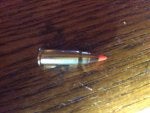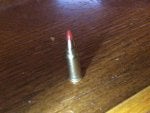This past summer I did some extensive testing of .17HM2 brands/lots with my Kimber K17 ProVarmint 20 inch barrel, at 50 and 100 yards. I tested 2 lots of Eley, 4 lots of Hornady, and 5 lots of CCI including CCI-VNT. The results of group size measurements showed that the lot/batch number had more effect on group size than brand. Usually, a flier would open up the group size, some worse than others. Thinking about this further, I went back to the sorting techniques published by Steve Boelter of ANA. He proposed that .17 HM2 accuracy could be improved by measuring bullet seating depth from ogive to rim base. I developed a measuring tool similar to his. I modified my rimfire gauge to measure the ogive length from the base of the rim, and sorted 11 lots of Eley, Hornady, and CCI (.17M2) into consistent groups.
I found that for my Kimber K17 ProVarmint there was a certain ogive length that gave consistently smaller groups with no fliers. Within any given lot the ogive length could vary by as much as .016" due to seating depth. This is considerable and points to the lack of quality control in these rounds. Hence no "match grade" ammo is available for .17M2 (and probably for .17HMR) simply due to variations in bullet seating depth, as well as other factors. One cannot measure the OAL with any meaningful results because the little plastic V-tip dimensions can vary by .010".
In my testing, the best sorted ammo lots made 5-shot groups at 50 yards as small as .377" while the same lot with different ogive lengths shot as poorly as 1.301".
For my rifle, the best groups were obtained with an ogive length of 0.983" regardless of brand. The ogive lengths seemed to vary by lot/batch number rather than brand. This is not surprising since all of today's .17HM2 is manufactured by CCI. I also noted that my 2 old lots of Eley had the lowest variation in bullet seating depth, which probably accounts for their reputation for accuracy.
I don't claim that sorting can make match grade ammo, but it did eliminate the fliers, at least for my rifle. Other rifle chambers may not be as sensitive as mine to variations in ogive length. (bullet seating depth).
It would be nice if CCI would step up to improve quality control, but I doubt that they would view that as cost effective.
I know others have stated that sorting rimfire ammo is a waste of time, and I have found that to be true of .22LR. However the .17M2 and .17HMR have copper jacketed bullets that seem to behave similar to centerfire rounds with respect to chamber pressure.
Other notes from this testing: I found that accuracy for my rifle dropped off after about 100 rounds and required barrel cleaning. I also tested some lots at 200 yards with disappointing results as most bullets key-holed in the target, probably due to the transition to sub-sonic velocity at about 180 yards. Several lots of Hornady showed higher velocity and did not key-hole. I concluded that the .17HM2 is only useful out to about 150 yards in my rifle. I found that these little plastic tipped bullets can act more like centerfire rounds than we are accustomed to with .22LR rounds.







